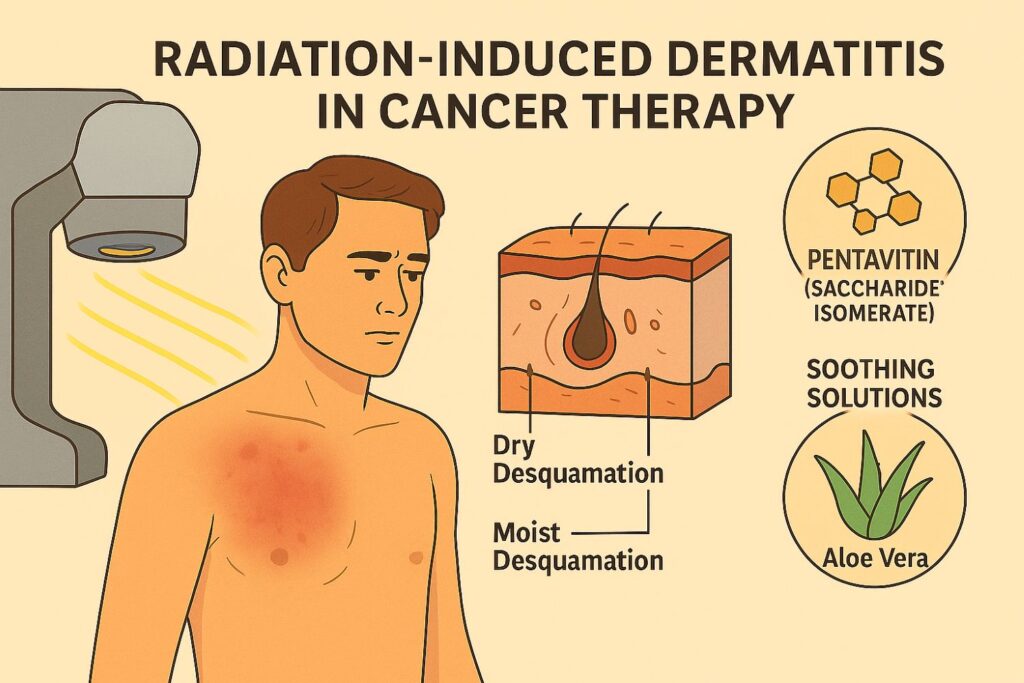Radiation therapy plays a vital role in the treatment of cancer, often used alone or in combination with chemotherapy or surgery. But for as many as 95% of patients, radiation comes with a painful side effect — Radiation-Induced Dermatitis (RID).
From mild redness to moist, weeping wounds, RID can impact treatment continuity and deeply affect quality of life. Fortunately, supportive skincare agents like Pentavitin (Saccharide Isomerate) and Aloe Vera show promising results in hydration and skin repair.
Let’s explore the science, symptomatology, and effective management strategies for RID.
What is Radiation-Induced Dermatitis?
RID refers to skin inflammation caused by ionizing radiation. It often presents during the second or third week of radiation therapy and peaks toward the end or shortly after treatment completion.
Common symptoms include:
- Erythema (redness)
- Dry, itchy skin (dry desquamation)
- Moist, peeling skin (moist desquamation)
- Burning or pain
- Crusting and ulceration in severe cases
A systematic review found that up to 95% of patients receiving external beam radiation develop some form of RID.
Why Does RID Occur?
Radiation not only targets tumor cells but also affects healthy basal keratinocytes in the skin. This leads to:
- DNA damage
- Cytokine release and inflammation
- Oxidative stress
- Disruption of the skin barrier
- Increased trans-epidermal water loss (TEWL)
These factors compromise skin regeneration and hydration, making effective topical support crucial.
Role of Supportive Skincare: Pentavitin and Aloe Vera
Pentavitin (Saccharide Isomerate)
Pentavitin is a patented plant-derived moisture-binding agent that mimics components of the skin’s Natural Moisturizing Factor (NMF). It forms a strong bond with amino groups in keratin, offering 72 hours of deep hydration, even after rinsing.
Benefits:
- Reduces TEWL (transepidermal water loss)
- Improves barrier repair
- Relieves dryness, itching, and flakiness
- Ideal for sensitive, irritated skin
Scientific Backing:
- Pentavitin has demonstrated significant hydration retention and barrier restoration in compromised skin models.
- Though no direct RID trials exist, its mechanism makes it a strong supportive agent for radiation-compromised skin.
Aloe Vera
Aloe Vera has long been used for its anti-inflammatory, soothing, and cooling properties. It contains polysaccharides, glycoproteins, and antioxidants that promote wound healing.
Clinical Evidence:
Patients pretreated with Aloe Vera are less likely to suffer from RID, thus the prophylactic application of Aloe Vera might significantly reduce the incidence of RID, especially in Grade 2 and Grade 3 RID.
Practical Skin Care Recommendations
- Start early: Begin moisturizing before or with the start of radiation.
- Use Pentavitin-containing creams or lotions twice daily.
- Avoid irritants: no alcohol-based or fragranced skincare.
- Wear loose, breathable clothing to prevent friction.
- Wash with lukewarm water and non-soap cleansers.
- Consult your Oncologist before applying any product during therapy.
Conclusion
Radiation-induced dermatitis may be inevitable in cancer therapy, but how we manage it can make all the difference. Ingredients like Pentavitin offer promising benefits for maintaining hydration and barrier integrity, key in minimizing radiation-related skin complications. Also, the prophylactic application of Aloe Vera might significantly reduce the incidence of RID, especially in Grade 2 and Grade 3 RID.
Supporting your skin throughout radiation isn’t just comfort care — it’s continuity care. The right choices can help patients’ complete treatment with fewer interruptions and better quality of life.
References
- Iacovelli NA, Ruggiero A, Berretta M, et al. Radiation-induced dermatitis in cancer treatment: A review of current options and future perspectives. Radiation Oncology Journal. 2020;38(2):98–105.
https://www.ncbi.nlm.nih.gov/pmc/articles/PMC7295106 - Sadowski T, Dreher F., et al. Saccharide isomerate as a water-retaining and barrier-restoring molecule: In vitro and ex vivo studies on its efficacy in compromised skin models. Proceedings of the 14th International Conference on Biomedical Electronics and Devices (BIODEVICES). 2019.
https://www.scitepress.org/PublishedPapers/2019/98375/98375.pdf - Tingting Wang, Jian Liao, et al. Aloe vera for prevention of radiation-induced dermatitis: A systematic review and cumulative analysis of randomized controlled trials https://pmc.ncbi.nlm.nih.gov/articles/PMC9557187/?utm


